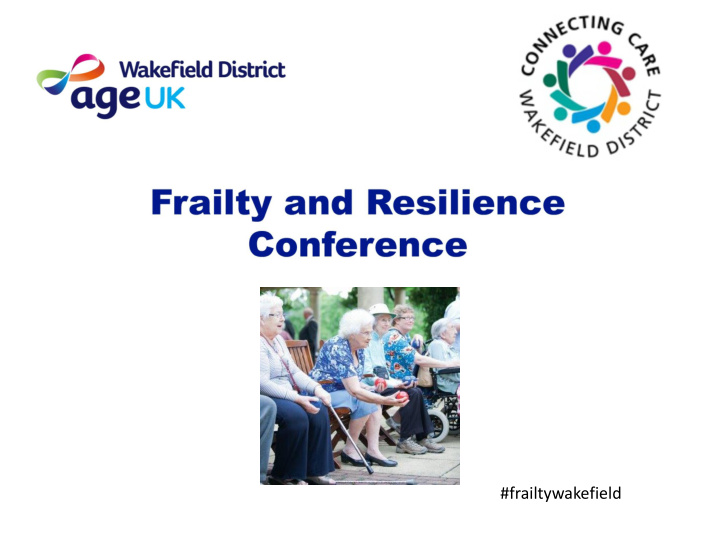



#frailtywakefield
Intervention and frailty: the Home-based Older People’s Exercise (HOPE) Programme Andy Clegg Senior Lecturer & Consultant Geriatrician University of Leeds & Bradford Royal Infirmary
Understanding frailty Condition characterised by loss of biological reserves and vulnerability to adverse outcomes Fit Mild frailty Moderate frailty Severe frailty Increasing frailty
Clinical presentation of frailty FUNCTIONAL ABILITIES Minor illness/acute Independent injury Dependent
Why does this happen???
Immobility in hospital is the enemy of an older person with frailty • Periods of immobility in older age are associated with accelerated loss of skeletal muscle function • Inflammatory response in acute illness further accelerates loss of muscle mass and strength • Seven day period of immobility = 10% loss of muscle mass and strength • For an older person at threshold strength for climbing stairs this can be the difference between independence and dependence
Current rehabilitation practice • Short period of rehabilitation on inpatient ward • Transfer to intermediate care – Community rehabilitation services – Predominantly for older people with frailty – Bed based (e.g. community hospital) – Home based – Time-limited (usually 2-6 weeks)
Problems with current approach 2014 UK National Audit of Intermediate Care 1. People frequently do not feel ready to return home 2. Risk of subsequent readmission 3. Benefits of rehabilitation are attenuated over time
Possible solution ‘What we need is a simple, generalisable intervention to address the condition of frailty & augment usual NHS rehabilitation …..........’
T h e H o m e - B a s e d O l d e r P e o p l e ’s E x e r c is e (H o p e ) P r o g r a m m e L e v e l O n e
HOPE Programme • Graded, progressive exercise programme • Aimed at improving strength, endurance and balance • Presented in an exercise manual and provided by community-based therapists • 3 times a day, 5 days of the week • 12 weeks (5 home visits & 7 telephone calls) • Further 12 weeks of telephone calls for sustainability
HOPE programme levels Level TUGT Participants Content 1 >30s Typically need assistance with walking, Simple chair-based climbing stairs, leaving the house exercises 2 20-29s Variability in mobility, balance and Chair-based, chair rise functional ability and standing exercises 3 <20s Typically get in/out of a chair and climb Chair rise and standing stairs without assistance exercises Participants can progress between levels based on repeat TUGT assessment
Research evidence • Tested in a pilot trial (84 participants) • Participants randomised to HOPE Programme or usual care • Evidence for feasibility, acceptability and safety • Preliminary evidence for improved mobility, using the timed-up-and-go test • What is next???
Clinical presentation of frailty FUNCTIONAL ABILITIES Minor illness/acute injury Independent Dependent
Clinical presentation of frailty FUNCTIONAL ABILITIES Minor illness/acute Independent injury Dependent
HERO trial • £2M funding from National Institute for Health Research Health Technology Assessment (NIHR HTA) Programme • Aim – To establish whether the HOPE programme for older people with frailty after discharge home from hospital or IMC is clinically and cost-effective
Research plan Multi-centre RCT x 718 participants 10 sites across 2 hubs (Yorkshire & South West) Mid Yorks have x confirmed interest in being a recruiting site
Eligibility & recruitment • Older people with frailty, aged over 65 & admitted to hospital with an acute illness or injury • Participants will be approached during their stay in hospital/intermediate care • Will be randomised immediately after discharge home • Care home residents, people with moderate/severe dementia, people receiving pallliative care are not eligible
Outcomes 1. Main outcome is quality of life at 12 months, measured using the SF36 physical component summary 2. Seondary outcomes (6 and 12 months) include mental health, activities of daily living, hospitalisation, care home admission, costs, cost-effectiveness • Plan to use postal questionnaires where possible • Also plan a detailed process evaluation, to understand how the HOPE programme was implemented & experienced
Example • Mrs Smith (84 years old) admitted to an elderly care ward with pneumonia • Lives with her husband and needs help with walking & bathing • After initial treatment, transferred to bed-based IMC • Approached by researcher a few days before planned discharge home to explain HERO trial • CFS score = 6 (moderate frailty); agrees to participate • Discharged home & randomised to HOPE programme • Contacted by therapy team & receives intervention • Completes follow-up assessments by post at 6 and 12 months
Clinical presentation of frailty FUNCTIONAL ABILITIES Minor illness/acute Independent injury Dependent
Thank you!!
Recommend
More recommend